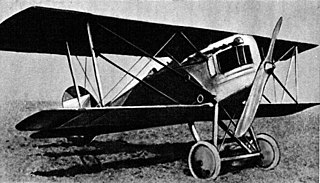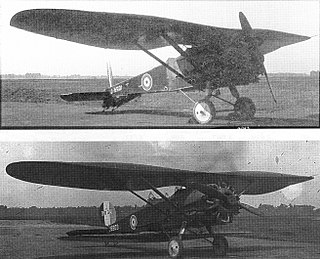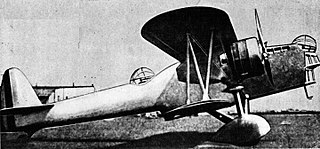
The Aero A.18 was a biplane fighter aircraft built in Czechoslovakia in the 1920s. It was a development of the Ae 02 and Ae 04 fighters Aero had designed during World War I, but also borrowed from the more recent A.11 reconnaissance-bomber design.

The Hawker Hawfinch was a British single-engined biplane fighter of the 1920s. It was unsuccessful, with the Bristol Bulldog being selected instead.

The Fairey Firefly IIM was a British fighter of the 1930s. It was a single-seat, single-engine biplane of all-metal construction. Built by Fairey Aviation Company Limited, it served principally with the Belgian Air Force throughout the 1930s until the outbreak of World War II.

The Fiat CR.1 was an Italian biplane fighter aircraft of the 1920s. Of wood-and-fabric construction, it was designed by Celestino Rosatelli, from whom it gained the 'CR' designation. Its most distinctive feature was that the lower wings were longer than the upper ones.

The Bristol Bloodhound was a British two-seat reconnaissance/fighter aircraft designed and built by the Bristol Aeroplane Company as a possible replacement for the Bristol F.2 Fighter for the Royal Air Force. It was unsuccessful, only four prototypes being built.

The Bristol Bullfinch was an experimental British military aircraft first flown in 1922. Variants were built as both parasol wing monoplanes and biplanes, but both versions proved unsuccessful, and only the three prototypes were built.

The Caproni Ca.165 was an Italian biplane fighter developed just before World War II, but produced only as a prototype, as the competing Fiat CR.42 Falco was selected for series production.

The Kawasaki KDA-5 was a Japanese single-seat biplane fighter designed by the German Dr. Richard Vogt for the Imperial Japanese Army.

The Vickers F.B.26 Vampire was a British single-seat pusher biplane fighter built by Vickers during the First World War.
The Renard Epervier was a Belgian prototype single-seat all-metal fighter monoplane designed by Alfred Renard at the Societé Anonyme Avions et Moteurs Renard for a government-sponsored design contest in 1928. The Epervier Type 2 was built and flown in 1928, by Belgian aircraft manufacturer Stampe et Vertongen. It carried an armament of two synchronised 7.7mm guns and was lost in September 1928 after failing to recover from a flat spin. A second prototype, the Epervier Type 2bis, introduced revised streamlined fairings for the cantilever mainwheel legs, mainwheel spats and cylinder aft-fairings and was built by SABCA.

The Fairey Fantôme, also known as the Fairey Féroce, was a British fighter prototype of the mid-1930s. The prototype was designed and built by Fairey Aviation and three production aircraft were assembled in Belgium by Avions Fairey.
The Bristol Type 101, was a British two-seat fighter prototype of the 1920s.
The Armstrong Whitworth Armadillo was a British single-seat biplane fighter aircraft built by Armstrong Whitworth.
The Beardmore W.B.II was a British biplane fighter prototype of the 1910s.

The Curtiss XF13C was a carrier-based fighter aircraft built by Curtiss Aeroplane and Motor Company.

The LACAB GR.8 Doryphore was a prototype Belgian multi-role combat aircraft of the 1930s. A twin-engined biplane, it was intended to carry out bombing and reconnaissance missions, as well as act as an escort fighter. It was already obsolete when completed and no more were built.

The Caproni Ca.70 was a two-seat night fighter and ground attack biplane produced in Italy in 1925. It was the only Italian aircraft designed from the outset as a night fighter.

The Caproni CH.1 was a single-seat biplane fighter, a single example of which was produced as a prototype in Italy in 1935.

The Wibault 12 Sirocco or Wib 12 Sirocco was a two-seat, parasol wing fighter aircraft designed and built in France in the 1920s. Three fighter prototypes were completed, one for the RAF and two Army co-operation variants. There was no series production.
The Hanriot H.33 was a French biplane 2-seat fighter aircraft built in 1926, derived from the Hanriot H.31. It was not successful and only one prototype was completed.

















